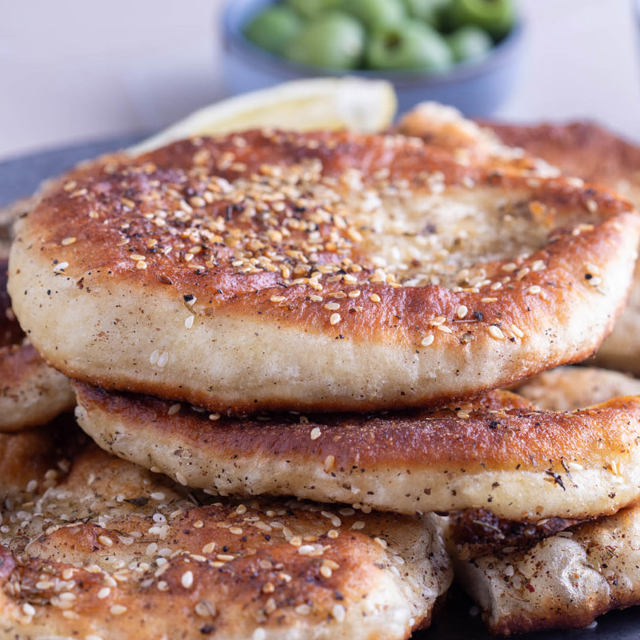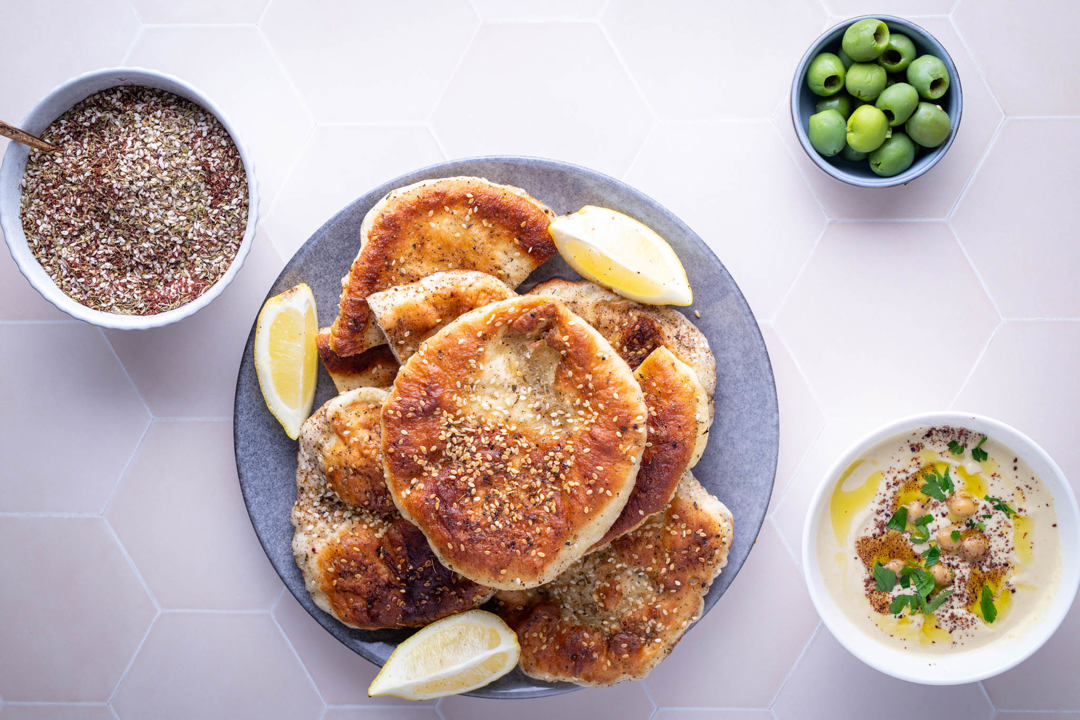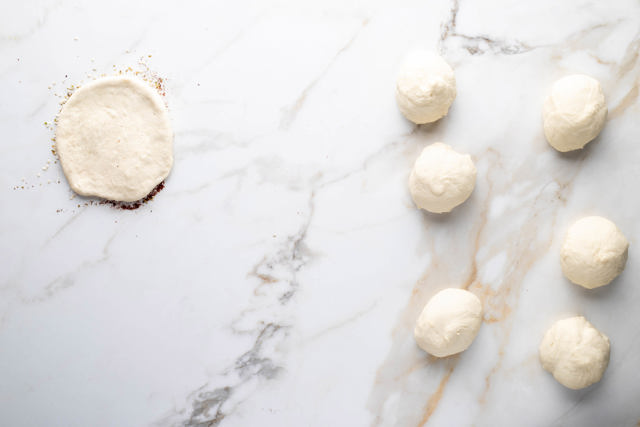This is a flatbread that's perfect for dipping into my best ever hummus or my spicy lamb-topped smoked hummus. Packed with Middle Eastern flavours, it's a soft and and tender - everything you want from a flatbread.
This recipe is based on my epic Greek pita bread, using it as the base. That recipe is tried and tested and serves as an excellent base for pita style bread. This recipe is similar to a Levantine flatbread called manakish, however manakish is baked and is sometimes topped with cheese or meat.
This is a super simple recipe that's easily made by hand, or with a stand mixer. Made with just flour, water, yeast, salt, sugar, olive oil and Homemade Za'atar spice blend. Home made bread is always better than anything made commercially, making it worth your time to make.
Because this is a relatively low hydration dough (62.5%) it's easy to work with and not too sticky.
What you need to make za'atar flatbread
- Stand mixer - you don't need a stand mixer, but the recipe is written for use with one. I have some notes below for making it by hand.
- Heavy-based skillet - preferably cast iron, you need a skillet with a heavy base so it can put the heat into the bread.
- Scales - bread ingredients really need to be weighed.
- Rolling pin.
Za'atar flatbread ingredients
As is common with most good breads, the core ingredients are
- Flour
- Water
- Yeast
- Salt
We also use some extra-virgin olive oil and sugar to improve the dough texture and moisture.
The bread is gently fried in olive oil after being dusted with Homemade Za'atar spice blend.
How to make za'atar flatbread
Combine ingredients - combine all dough ingredients together in your stand mixers bowl.
Mix - using a dough hook, mix for 8 minutes on low speed (1).
Bulk ferment - remove the bowl from your stand mixer and cover with a tea towel and place in a warm place until the dough has doubled in size (about an hour).
Degas the dough by tearing it away from the side of the bowl.
Portion - weigh the dough and divide by 14. Portion the dough into equal sized balls.
Shape - once the dough has been portioned into individual pieces, take one portion and gently cup it with your fingers. Using a circular motion, roll the dough against the work surface, applying slight pressure with your palms, until it forms a smooth, round ball. Repeat this process for each portion, ensuring consistent size and shape for uniform rolls.
Rest - allow the dough balls to stand for 10 minutes for the gluten to relax.
Preheat skillet - preheat a cast iron skillet (or other heavy based pan) over medium heat.
Roll out - use a rolling pin to roll a dough ball out to a circle about 100mm around (4"). The dough shouldn't be too sticky, but if you find that it is, add a little flour to the bench and top of the dough.
Dust in za'atar - Add the za'atar to a bowl, plate or to your bench and press each side of the dough into the za'atar before cooking it.
Cook - as you cook the flatbread, make sure that you keep the oil level up in the pan. You should have around 5mm (3/16") of oil in the pan to ensure even cooking at all times. Add as many flatbreads as you can fit into the pan without crowding. While the bread is cooking. roll out the next dough balls. Use tongs to flip the bread in the pan when needed - there should be some browning but don't let it burn.
Remove from pan and allow to cool on a wire rack. Repeat the cook step until you've cooked all your dough.
Tips
- High protein flour - use a high protein flour, not a cake flour. Aim for at least 11%. Using a higher protein flour will work, but might be chewier.
- Preheat the skillet before you start cooking the flatbread.
- After shaping allow the dough to relax for at least 5 minutes before you roll out your first pita. If you don't allow the dough to relax, you'll see it pull back in on itself while you're rolling it out.
- Making bread takes practice - make different types of bread and learn how the dough behaves and how it should feel. It's affected by relative humidity, gluten content of flour, ambient temperature, and a heap of other variables. Don't be dissuaded if your first attempt doesn't work.
- Don't roll too thinly - while this is based on my pita bread recipe, it's not meant to be as thin as pita bread. We want the dough to rise and end up around 2cm tall (around 1"). Roll out to around 8-10mm thick (around 5/16").
What is za'atar?
Originating from Middle Eastern / Levantine cuisine - think Israel, Jordan, Lebanon, Palestine and Syria - za'atar (pronounced ZAH-tar) is a spice blend that packs a serious punch and is often used as a seasoning with pita breads, meats, vegetables or sprinkled over dips such as hummus.
Za'atar is made with herbs and spices including sesame seeds, sumac, salt, oregano, marjoram and thyme. Use it like you would salt to add a middle eastern flair to your food!
You can read more about za'atar here - Homemade Za'atar spice blend.
Za'atar ingredients
- Sumac is used to bring a tangy, lemony flavour.
- Sesame seeds - not always used, but I find they bring a great flavour and texture. You can optionally toast them in a skillet if you want to enhance the sesame flavour.
- Oregano - preferably use a Greek or Italian oregano, not Mexican.
- Thyme
- Marjoram - optional, replace with thyme & oregano if you choose not to use.
- Salt
How do I knead by hand?
To knead dough by hand, begin with a lightly floured surface to prevent sticking. Place the dough on the floured surface and use the heel of your hand to gently press it away from you. Fold the dough in half towards you and rotate it a quarter turn. Continue this process for about 8-10 minutes or until the dough becomes smooth, elastic, and passes the "window pane test".
To perform the window pane test, take a small piece of dough and gently stretch it between your fingers. If the dough stretches into a thin, translucent membrane without tearing, it's ready. If it tears easily, continue kneading for a few more minutes.
While you're kneading, adjust the flour as needed to maintain a slightly tacky but not overly sticky consistency.
Using a stand mixer
Use your stand mixer on a low speed - generally 1 or 2, but consult your manual to confirm - with a dough hook to knead the dough.
This is a low hydration dough which makes it difficult for a stand mixer to mix. If you have a less expensive mixer, keep an eye on it while it's kneading and stop if the motor starts to smell, gets excessively hot, stalls or is regularly slowing down. Kitchenaid mixers are fine with this hydration.
Do I need to use bread flour?
No, regular all purpose flour is fine. Aim for a protein percentage of around 11-12%. You can use bread flour, which is higher protein, but it will be chewier. Using a cake flour (under 10%) is not recommended.
Storing cooked flatbread
Allow the flatbread to cool to room temperature before placing in a plastic bag - I use an empty loaf bag. Store in the fridge for 3 days, or freeze for up to 3 months. Make sure the bag is air tight to avoid the bread from drying out in the fridge or freezer.
Return the flatbread to freshness by microwaving briefly - it will soften when it warms up.
What to serve with Za'atar flatbread
This recipe was purpose made to go with my spicy lamb-topped smoked hummus.

Za'atar flatbreads
| Prep | Cook | Total |
|---|---|---|
| 10 mins | 20 mins | 90 mins |
- 800g all purpose flour 11-12% protein, see note 1
- 500ml luke warm water around 30C/86F
- 1 tbsp sugar
- 1 tbsp salt
- 2 tsp dried yeast
- 4 tbsp extra virgin olive oil
- Za'atar see note 2
- Olive oil or other neutral oil - not extra virgin
- Combine ingredients - combine all dough ingredients together in your stand mixers bowl.
- Mix - using a dough hook, mix for 8 minutes on low speed (1).
- Bulk ferment - remove the bowl from your stand mixer and cover with a tea towel and place in a warm place until the dough has doubled in size (about an hour).
- Degas the dough by tearing it away from the side of the bowl.
- Portion - weigh the dough and divide by 14. Portion the dough into equal sized balls.
- Shape - once the dough has been portioned into individual pieces, take one portion and gently cup it with your fingers. Using a circular motion, roll the dough against the work surface, applying slight pressure with your palms, until it forms a smooth, round ball. Repeat this process for each portion, ensuring consistent size and shape for uniform rolls.
- Rest - allow the dough balls to stand for 10 minutes for the gluten to relax.
- Preheat skillet - preheat a cast iron skillet (or other heavy based pan) over medium heat.
- Roll out - use a rolling pin to roll a dough ball out to a circle about 100mm around (4"). The dough shouldn't be too sticky, but if you find that it is, add a little flour to the bench and top of the dough.
- Dust in za'atar - Add the za'atar to a bowl, plate or to your bench and press each side of the dough into the za'atar before cooking it.
- Cook - as you cook the flatbread, make sure that you keep the oil level up in the pan. You should have around 5mm (3/16") of oil in the pan to ensure even cooking at all times. Add as many flatbreads as you can fit into the pan without crowding. While the bread is cooking. roll out the next dough balls. Use tongs to flip the bread in the pan when needed - there should be some browning but don't let it burn.
- Remove from pan and allow to cool on a wire rack. Repeat the cook step until you've cooked all your dough.
- Flour - all purpose is fine; ideally 11-12% protein. Bread flour is also fine, but the pita will be chewier. Avoid low protein flours (such as cake flour).
- Za'atar is a Middle Eastern spice blend flavoured with sumac, herbs and usually sesame seeds. You can use my za'atar recipe to make it, or purchase it from most supermarkets.
- Rolling out - the yeast will be active, so don't roll the bread out until a minute or so before you're ready to cook it.
- Oil - keep a close eye on the temperature to avoid burning the za'atar ingredients, particularly sesame seeds. Discard the oil if required. Maintain around 5mm of oil in the bottom of your skillet.






























